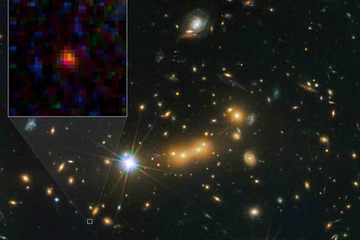Some people call a 13.7 billion year old universe ancient, but others think it’s held up nicely and doesn’t look an eon over five billion. Or in Bobby Jindal’s lesser epochs, a day over 5,000 years. But however one mismeasures time, lo those many billennia ago, there was at least one galaxy burning bright, and where there’s one modest-sized super massive black-hole embedded in dark matter cloud with a frothy retinue of stars and dust and maybe even planets, there’s probably a billion more:
Space.com— A new celestial wonder has stolen the title of most distant object ever seen in the universe, astronomers report. The new record holder is the galaxy MACS0647-JD, which is about 13.3 billion light-years away. The universe itself is only 13.7 billion years old, so this galaxy’s light has been traveling toward us for almost the whole history of space and time.
Astronomers spotted the object using NASA’s Hubble and Spitzer space telescopes, with the aid of a naturally occurring cosmic zoom lens as well. This lens is a huge cluster of galaxies whose collective gravity warps space-time, producing what’s called a gravitational lens. As the distant galaxy’s light traveled through this lens on its way to Earth, it was magnified.
In case you;re wondering about the billennia, light went very, very fast back then. It has sinced slowed down, a lot, as light grew quite tired from its long journey across the cosmos, without violating half a dozen paradoxes and leaving behind no evidence whatsoever of that magnificent relativistic miracle. QED


This has always confused me, probably because all I know about it came from TV shows (some of them I think pretty good TV shows, but still).
So we see the most distant objects as they were 13.3 billion years ago. Aren’t we also seeing them where they were 13.3 billion years ago? Not to mention that since the light left them, they have obviously changed/grown/died/merged/evolved during the intervening 13 billion years… so where and what are they today?
And if the most distant objects were where we see them all that long ago, where are they now? Isn’t the finite universe much larger (and older) if our current perception of its state is based on its state only a few million years after the big bang?
If space expands (or expanded, in the past) faster than C, but our only tool to measure it is C, can we ever get an accurate estimate of either its size or age?
Erm, sorry about any redundant redundancies in that, ignore anything that feels clumsy. (I’ll take ‘an edit button’ for $300, Alex)
comfychair:
You’re absolutely right in that all you can really say is that the light has been travelling 13.3 billion years. The source wasn’t 13.3 billion light years away when the light was emitted (obviously) but neither is it 13.3 billion ly distant now (but much farther due to expanding universe). The article Stephen quoted actually claims the distance is 13.3 bly, but they seem to be making this very common mistake.
The “age of light” = “distance in light years” would only really work in a static universe.
listen — strange astonomers huddled in in our solar system distributing stellar spectra is no basis for a system of galactic generation. supreme predictive power derives from a perusal of the bible, not from some farcical astronomic observation. i mean, if I went around sayin’ the universe was 13.7 billion years old just because some astrophysicist had used the Hubble and Spitzer telescopes they’d put me away!
#4:
Little difficulty in grasping reality? A little confusion between myth and data? Troll thee elsewhere.
@peterh #5:
Please compare #4 to this sacred text.
peterh, I think you need to get your sarcasm/humor meter recalibrated.
robb@4: That was brilliant (or an awful troll, but I’m going to go with brilliant, based on the MP reference).
peterh turned me into a troll. but i got better.
Now, how in tunket is a migrating swallow supposed to carry any respectable telescope?
Did anyone see Karl Rove’s Black Knight impersonation on Election night?